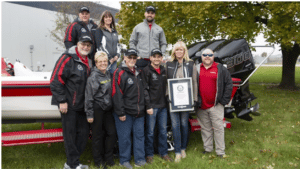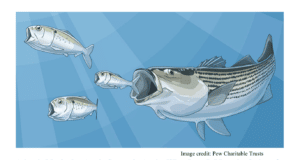Propped Up
I have a 2004 Sea Ray Sport with a MerCruiser 4.3-liter carbureted engine. The boat originally came with a 23″-pitch prop and I was lucky to get it to 4100 rpm. Recently I switched to a 21″ pitch Stiletto 2 stainless-steel prop. I’m not seeing any rpm change-should I? Frank Witbrod, Ellijay, GA
Does the 21″-pitch prop have a lot more rake than the 23″? If so, that could make the difference. Often, though, if you put on a smaller prop and you’re not getting any more rpm out of the motor, you either have a faulty tachometer or a fuel problem. I went through this with my own boat while testing different propellers and wound up replacing the fuel pump. Let’s start simpler, though. Replace your fuel/water separator and make sure your boat’s fuel lines have no sharp bends. Next, check your fuel vent hose to make sure it’s free of obstructions.
Keyed Up
My Regal Sebring has a 205- hp 4.3-liter engine. To get the motor started at the beginning of the day, I must jump across the solenoid while someone else turns the key switch. I removed and cleaned all the connections at the solenoid before we put the boat in the water, hoping to solve the problem, but the next time I tried to fire it up, I had to jump across the solenoid again. The next several times we shut off and restarted, it was fine.
Douglas Diefenbach, Morton, IL
More than likely, it’s either the ignition switch or the 10-pin harness plug-in connection at the motor. For the key switch, once it gets warmed up and dries out whatever moisture is in there, the current flows through more easily. For the 10-pin harness connection, unplug it and make sure there’s no corrosion on the terminals and that they are all straight.
Forgotten Hero__
__Every year I faithfully winterize my boat. I drain and fill the lower unit’s gearcase, clean the battery posts with a wire brush, grease all the necessary fittings, change impellers every other season, and even place mothballs onboard to keep critters away. So I have only one question: How should I winterize the trailer?
Max Meyer, Raymond, ME
Put the trailer on jack stands and spin the wheels by hand. If you hear growling, you need to check the bearings and possibly replace them. If they turn smoothly, give them a good coating of grease. Then fill the tires with the recommended amount of air. I pay extra for nitrogen because it doesn’t fluctuate with the ambient temperature. Also, spray down the winch with some WD-40 or even fogging oil to make sure that any residual road salt doesn’t corrode it. Finally, make a cover for your taillight plug-use an extra connector and plug it in place to protect the terminals during the long, cold winter.
Put a Cork in it
Ever do the drain plug double take? you know that sinking feeling: Did I insert the drain plug? Well, Seasense’s One-Way Plug is a new product to failsafe against your fading memory. This patented one-way transom plug is made from solid brass and easily installs in less than an hour. For testing purposes, I replaced an existing plug in my dinghy. The design is similar to a standard check valve and, when oriented low in a transom, will allow water to drain out but not seep back in. Before launching, I turned on the hose and poured in about five gallons of water. It drained without a problem. Then to prevent loss, I tied a length of light line from a stainless-steel eye I use for the outboard to the hole in the supplied brass 1/2″ plug and snugged it up into the fitting. Don’t try this on your boat, but after launching, I went for a short ride and took on a bucketful of saltwater. I opened the plug from the fitting to see what would happen and was gratified to find that the water drained. Leaving the plug out, I shut off the motor and when we lost way, no water came in.
Price: $10. Contact seasense at www.seasense.com.
Forward Thinking
We own a Donzi 33′ with twin 7.4L Bravo Ones. Recently, I came off plane while approaching a lock and tried to shift into reverse, but the port drive wouldn’t engage. The following day and for the rest of the season, it would shift fine when cold, but after a good run when everything was hot, it stopped going in reverse.
Denis Lajoie, Hawkesbury, Ontario
Look at the inner shift cable between the engine and the outdrive; it’s the lower cable on the shift plate at the engine. Follow it down from the engine past the lower exhaust bullhorn where it goes into the drive. If it looks worn, frayed or otherwise damaged, you’ve found the problem. If the cable looks okay, the problem is inside the drive itself.
Stripped Bar
The first day out on my new boat I hit a sand bar. The only damage I can see is that the glossy part of the paint has come off the bottom third of the Mercury lower unit. Should I attempt to repaint it?
Tom Puett, Joliet, IL
Yes. Repaint it for corrosion protection, resale value, and aesthetics. Prime it with a zinc chromate-based material and then go to your Mercury dealer and get the proper touch-up paint to match. Otherwise you’ll go through anodes faster.
Unfaithful
My MerCruiser 350 is an enigma. If it sits for a week, it will run for 40 minutes or longer and then die, as if out of gas. Then it restarts and runs for a minute and dies again. Each time I restart, it runs for only a few seconds. A new fuel filter failed to help.
Robert B. Bishop, Dublin, OH
The engine will run for the first 40 minutes because the choke is delivering extra fuel to keep it going. If your engine has a Rochester Quadrajet carburetor, I bet that the problem is an air leak somewhere between the throttle plate and carburetor body. The gasket between the two may have a rip or tear that’s causing the leak. Patch the gasket with Permatex #2 gasket sealer, which is available at most auto parts stores.
GOOD FOR WHAT AILS YA
Tired of cleaning dead bugs off the radome? Before you leave home, wrap it in Saran Wrap. Rip the wrap away at the ramp, and the radome will be bug-free.








